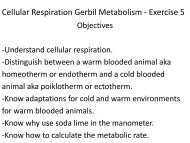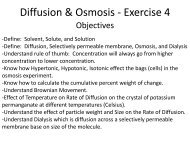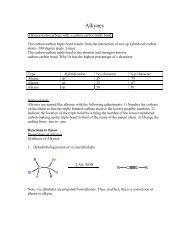Enzymes - Exercise 3 - Science Learning Center
Enzymes - Exercise 3 - Science Learning Center
Enzymes - Exercise 3 - Science Learning Center
Create successful ePaper yourself
Turn your PDF publications into a flip-book with our unique Google optimized e-Paper software.
<strong>Enzymes</strong> - <strong>Exercise</strong> 3 - Germantown<br />
Objectives<br />
-Understand the function of an enzyme.<br />
-Know where catechol oxidase (enzyme) used in today’s<br />
experiment came from.<br />
-Understand why enzymes require a cofactor.<br />
-Understand how PTU (phenylthiourea) affects the enzyme.<br />
-Understand the specificity for enzymes affect the molecules<br />
Catechol & Hydroquinone<br />
-Understand how at different environments (temperature &<br />
pH affect an enzyme.
• <strong>Enzymes</strong> are proteins that act as catalysts. Catalysts increase the rate of a<br />
chemical reaction without being consume by the reaction. <strong>Enzymes</strong> are not<br />
altered during a reaction and therefore they can be reused again and again.<br />
• An enzyme speeds up a reaction by lowing the reaction’s activation energy.<br />
All reactions require some energy to get started (activation energy).<br />
<strong>Enzymes</strong> lower the activation energy they do not provide activation energy.<br />
All chemical reactions require activation energy (Ea). Without enzymes<br />
reaction in cells would be slow and take a very long time.<br />
• <strong>Enzymes</strong> are specific for certain reactions. There three dimensional<br />
structure (tertiary structure) determines their specificity (FORM FITS<br />
FUNCTION). Temperature, pH, and salt concentration can alter the<br />
enzyme’s tertiary structure, thereby alerting the enzyme’s function.<br />
• In an enzymatic reaction, substrates bind to an enzyme’s active site,<br />
creating an enzyme-substrate complex (ES). The enzyme-substrate complex<br />
then turns into an enzyme-product complex (EP). Finally, the enzymes<br />
detach from the product (P) and the reaction is complete.<br />
• The function of the enzyme is dependent on the shape of its active site.
<strong>Enzymes</strong><br />
• Speed up chemical reactions (catalysts).<br />
• Work by lowering the activation energy.<br />
• Reactants the enzyme acts upon are called substrates.<br />
sucrose + sucrase + H 2 O glucose + fructose<br />
(substrate) (enzyme) (water) (products)<br />
• Very specific for reactions.<br />
• Three dimensional shape determines function (tertiary,<br />
quaternary structure).<br />
• Active site is region where the substrate binds.<br />
• <strong>Enzymes</strong> are not altered in a reaction and can be used again.
Substrate Specificity of <strong>Enzymes</strong><br />
• The substrate<br />
– Is the reactant an enzyme acts on<br />
• The enzyme<br />
– Binds to its substrate, forming an enzymesubstrate<br />
complex<br />
• The active site<br />
– Is the region on the enzyme where the<br />
substrate binds
In an enzymatic reaction the substrate binds to the active site<br />
• The catalytic cycle of an enzyme<br />
1 Substrates enter active site; enzyme<br />
changes shape so its active site<br />
embraces the substrates (induced fit).<br />
2 Substrates held in<br />
active site by weak<br />
interactions, such as<br />
hydrogen bonds and<br />
ionic bonds.<br />
Substrates<br />
6 Active site<br />
Is available for<br />
two new substrate<br />
Mole.<br />
Enzyme<br />
Enzyme-substrate<br />
complex<br />
3 Active site (and R groups of<br />
its amino acids) can lower E A<br />
and speed up a reaction by<br />
• acting as a template for<br />
substrate orientation,<br />
• stressing the substrates<br />
and stabilizing the<br />
transition state,<br />
• providing a favorable<br />
microenvironment,<br />
• participating directly in the<br />
catalytic reaction.<br />
5 Products are<br />
Released.<br />
Figure 8.17<br />
Products<br />
4 Substrates are<br />
Converted into<br />
Products.
When plant tissue is exposed to the air, it produces a brown colored chemical called benzoquinone.<br />
Benzoquinone accumulates in the tissue and helps it to protect it from microbes , such as, bacteria and<br />
fungi that cause riot. This protective reaction in plants is shown here:<br />
.<br />
Page 30 – Lab Book<br />
In all of these cases, oxygen gas in the air is combined with catechol in the damaged plants<br />
cells to produce benzoquinone<br />
Three notable examples of this reaction in plants is observed in a peeled potato exposed to air, in a<br />
partially eaten apple, or in a pear or other fruit that has been bruised.<br />
The enzyme catechol oxidase to be used. It was derived from fresh potatoes made into a milky<br />
mixture called potato extract and stored on ice in brown bottles.<br />
The potato extract contains the enzyme catechol<br />
oxidase.
So how do you know when there’s a reaction? When the<br />
reaction turns a brownish color that tells us the activity of<br />
the enzyme. The darker brown it is, the more product you<br />
have for that particular environment, wheatear it is<br />
temperature or pH.<br />
Page 31 – Lab Book
Pages 31– Lab Book<br />
• 2. What two chemicals are necessary produce the brown product?<br />
Catechol & oxygen (oxygen gas)<br />
• 3. Why are tubes C1 and C2 called control tubes?<br />
C1) Has 3ml potato extract; 3 ml distilled water<br />
C2) Has 3 ml 1% catechol; 3 ml distilled water, it has both of the<br />
chemicals that we tested but in the experiment we put both substances
• Many enzymes require a cofactor (metal<br />
ion or coenzyme), which acts to either<br />
maintain the shape of the enzyme<br />
molecules or to interact with the substrate<br />
at the active site of the reaction can<br />
proceed. Another example is Fe with RBC’s.<br />
Fe carries the oxygen.<br />
• Cu is the cofactor for catechol oxidase.<br />
• PTU is an abbreviation for the molecule<br />
phenylthiourea, which can bind to copper<br />
ions (Cu), cofactor, to the enzyme.
PTU - Phenylthiourea<br />
• PTU: This would bind to Cu+, so if there’s only Cu in the solution of enzyme the PTU is going<br />
to bind and pick up the Cu.<br />
• What you’re testing is whether the enzyme needs Cu, so tested this with and without PTU<br />
too. Not testing whether PTU is cofactor, the test is to see whether Cu is cofactor, the PTU is<br />
strictly used to make Cu out of the solution. Cu is known as the cofactor.<br />
• PTU is a chemical that binds Cu better than the enzyme binds Cu. So what it does is it goes<br />
around, and it acts like a vacuum cleaner, and takes all the Cu from any of the enzymes<br />
that has it.<br />
• If this enzyme Catechol oxidase needed Cu, Cu is no longer available when PTU is there<br />
because the PTU got the Cu because it likes it better than the Catechol oxidase (the<br />
enzyme).<br />
• The Cu got taken away, so the enzyme doesn’t work if it doesn’t work Cu. So somebody<br />
stole its Cu. So because it was inhibited it does require Cofactor because it was inhibited.<br />
• Adding PTU makes the enzyme not function.
Specificity for enzymes - Page 34 – Lab Book<br />
Notice that the position of the hydroxyl (OH-) groups is<br />
different in the two molecules. For catechol, the hydroxyl<br />
groups to the benzene ring are adjacent to one another, while<br />
for hydroquinone the hydroxyl groups are opposite one<br />
another. In other words, they have each a slightly different<br />
shape.
Specificity for <strong>Enzymes</strong> - Catechol & Hydroquinone<br />
• If the temperature and pH are optimal, the enzyme will bind<br />
tightly to the substrate and the chemical reaction will occur.<br />
In this section of the lab exercise, you will compare two very<br />
similar, though not identical, molecules and determine if<br />
either one of them or both of them can be hydrolyzed by the<br />
enzyme oxidase into the brown product benzoquinone:<br />
• 2 molecules: Catechol and hydroquinone. They have slightly<br />
different shapes.<br />
• Procedure:<br />
-To tube A, add 3 ml of potato extract and 3 ml of 1% catechol.<br />
-To tube B, add 3 ml of potato extract and 3 ml of 1% hydroquinone.
Effect of Temperature on the rate of Enzyme activity<br />
• Chemists have long known that an increase in temperature<br />
will increase the rate of a chemical reaction. Effect of<br />
temperature on the activity of the enzyme catechol oxidase.<br />
• Consider the following two facts: 1) An increase in<br />
temperature increases molecule motion and therefore<br />
collision rates between substrates and enzyme. 2)<br />
<strong>Enzymes</strong>, being globular proteins, are denatured at high<br />
temperatures. Their shape is changed as the high<br />
temperature breaks some chemical bonds that maintain<br />
secondary and tertiary protein structure. In this way, the<br />
shape of the enzymes active site is altered.<br />
• Temperature: Optimal: Effect of temperature of enzyme<br />
activity. Proteins are denatured at high temperatures.
Rate of reaction<br />
Effects of Temperature<br />
• Each enzyme<br />
– Has an optimal temperature in which it can<br />
function<br />
Optimal temperature for<br />
typical human enzyme<br />
Optimal temperature for<br />
enzyme of thermophilic<br />
(heat-tolerant)<br />
bacteria<br />
0 20 40 80 100<br />
Temperature (Cº)<br />
(a) Optimal temperature for two enzymes<br />
Figure 8.18
Temperature Page 37 – Lab Book
Temperature Page 37 – Lab Book
Effect of pH on the Rate of Enzyme Activity<br />
• All enzymes have a pH optimum at which they are<br />
able to catalyze reactions most efficiently. To<br />
analyze the effect of different pHs on the activity of<br />
the enzyme catechol oxidase, the use of buffers is<br />
required. Buffers are substances that help<br />
maintain a constant pH in a mixture by stabilizing<br />
the amount of hydrogen ions present in the<br />
mixture. The experiment will use buffers that vary<br />
from strong acids (pH 2) to neutral (pH 7) to strong<br />
bases (pH 12). <strong>Enzymes</strong>, proteins, are<br />
practically or completely denatured if the<br />
pH is changed from the optimum pH.
Increasingly Acidic<br />
[H + ] > [OH – ]<br />
Increasingly Basic<br />
[H + ] < [OH – ]<br />
Rate of reaction<br />
<strong>Enzymes</strong> have an optimal pH in which it can function<br />
Neutral<br />
[H + ] = [OH – ]<br />
pH Scale<br />
0<br />
1<br />
2<br />
3<br />
4<br />
5<br />
6<br />
7<br />
8<br />
9<br />
10<br />
11<br />
12<br />
13<br />
14<br />
Battery acid<br />
Digestive (stomach)<br />
juice, lemon juice<br />
Vinegar, beer, wine,<br />
cola<br />
Tomato juice<br />
Black coffee<br />
Rainwater<br />
Urine<br />
Pure water<br />
Human blood<br />
Seawater<br />
Milk of magnesia<br />
Household ammonia<br />
Household bleach<br />
Oven<br />
cleaner<br />
The pH of a solution<br />
-Is determined by the relative concentration of<br />
hydrogen ions (H+)<br />
-Is low in an acid<br />
-Is high in a base<br />
Optimal pH for pepsin<br />
(stomach enzyme)<br />
Optimal pH<br />
for trypsin<br />
(intestinal<br />
enzyme)<br />
0 1 2 3 4 5 6 7 8 9<br />
(b) Optimal pH for two enzymes
pH Page 40 - Lab Book
pH Page 40 - Lab Book
• 1. What is an Enzyme?<br />
Questions<br />
• 2. <strong>Enzymes</strong> increase the rate of a reaction by.<br />
A. Decreasing the requirement of activation energy.<br />
B. Providing the activation energy to the reaction.<br />
C. Both A & B<br />
D. None of the above.<br />
• 3. Do you expect an enzyme to be active at 0 degrees C. Why?<br />
• 4. Name three physical and chemical factors that affect enzyme’s activity<br />
(denature a protein/enzyme)?<br />
• 5. All enzymes function optimally at PH 7.4<br />
True or False
Questions<br />
• 1. What is an Enzyme: A protein catalyst that speeds up a reaction without<br />
getting consume in a chemical reaction. It lowers the activation energy barrier<br />
too.<br />
• 2. <strong>Enzymes</strong> increase the rate of a reaction by.<br />
A. Decreasing the requirement of activation energy.<br />
B. Providing the activation energy to the reaction.<br />
C. Both A & B<br />
D. None of the above.<br />
• 3. Do you expect an enzyme to be active at 0 degrees C. Why? Yes, the enzyme is<br />
still active but is working at slower rates.<br />
• 4. Name three physical and chemical factors that affect enzyme’s activity (denature<br />
a protein/enzyme)?<br />
Temperature, pH, Concentration (salt), Cofactors, & Inhibitors<br />
• 5. All enzymes function optimally at PH 7.4<br />
True or False
Questions<br />
• 6. What is the importance of enzyme in living<br />
systems?<br />
• 7. The optimum temperature of our enzyme was?<br />
• 8. In general, as temperature increases, the rate of<br />
enzyme activity (increases/decreases) up to a<br />
certain point called the optimum temperature, at<br />
which activity is at a maximum. After this point,<br />
activity (increasing/decreases). At very high<br />
temperatures we see (high/low/no) activity because<br />
the enzyme is denatured.
Questions<br />
• 6. What is the importance of enzyme in living systems?<br />
<strong>Enzymes</strong> speed up chemical reactions by lowering Ea.<br />
• 7. The optimum temperature of our enzyme was 35<br />
degrees Celsius.<br />
• 8. In general, as temperature increases, the rate of<br />
enzyme activity (increases/decreases) up to a certain<br />
point called the optimum temperature, at which<br />
activity is at a maximum. After this point, activity<br />
(increasing/decreases). At very high temperatures we<br />
see (high/low/no) activity because the enzyme is<br />
denatured.
Questions<br />
• Draw a curve representing enzyme activity as it<br />
changes with temperature. Label the point of the<br />
optimum temperature.
Questions<br />
• Draw a curve representing enzyme activity as it<br />
changes with temperature. Label the point of the<br />
optimum temperature.







